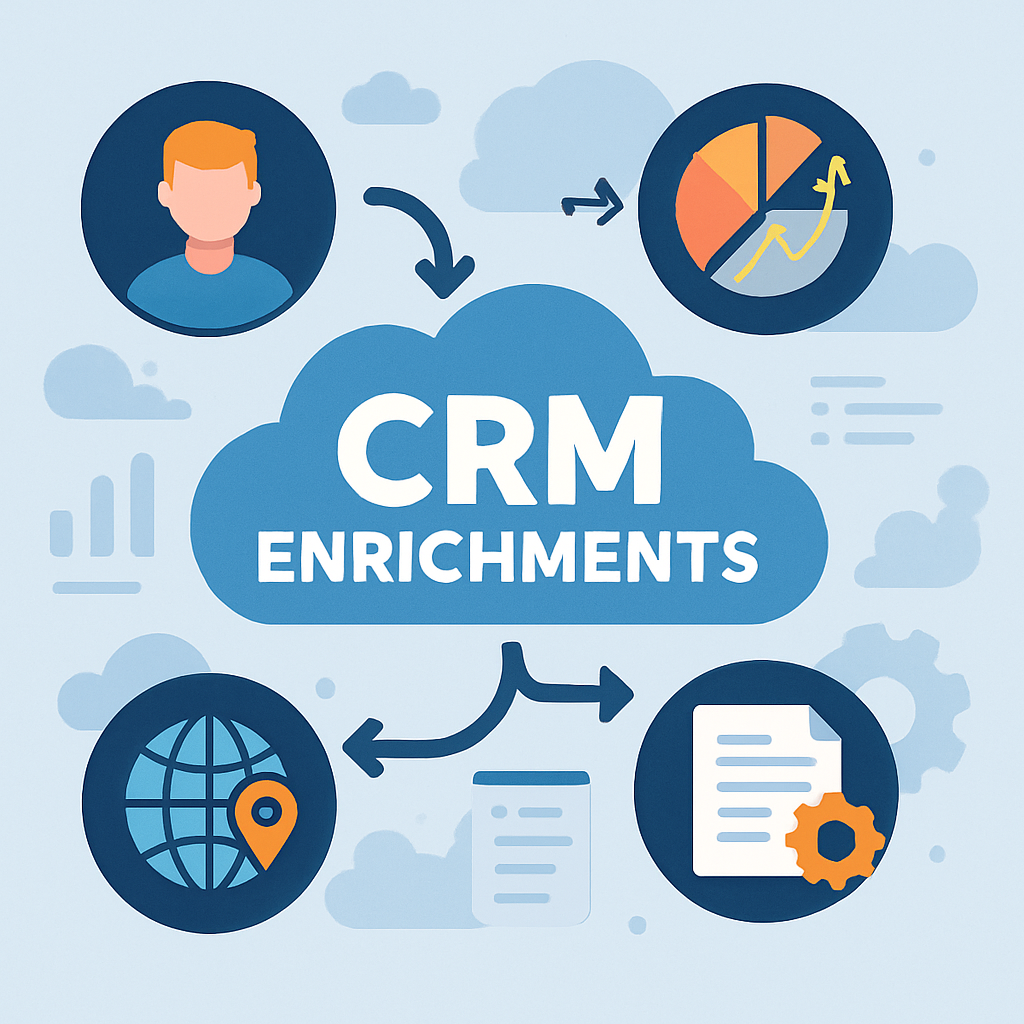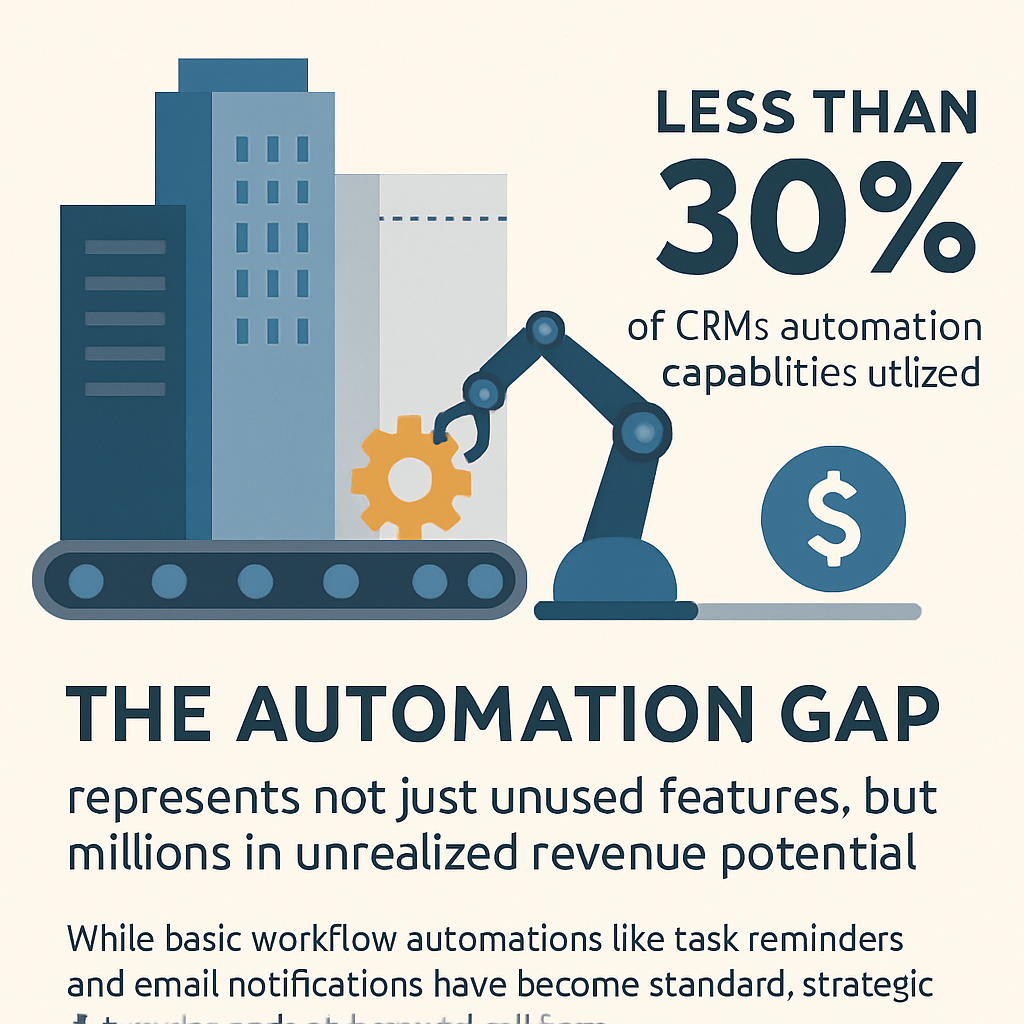Introduction
In today’s data-driven business environment, your Customer Relationship Management (CRM) system is only as valuable as the data it contains. According to recent research, organizations lose an average of $15 million annually due to poor data quality, with incomplete or inaccurate CRM data playing a significant role in these losses. Despite substantial investments in CRM platforms, many businesses are essentially operating with digital filing cabinets rather than strategic assets that drive growth.
CRM enrichment—the process of enhancing your customer and prospect data with additional, relevant information—transforms this reality. Companies implementing strategic enrichment initiatives report 29% improvement in sales productivity, 42% higher lead conversion rates, and 35% more accurate sales forecasting. These aren’t incremental gains; they represent transformative returns on what is often a modest investment in data quality.
Section 1: Understanding CRM Enrichment
Definition and Scope of Modern CRM Enrichment
CRM enrichment involves augmenting your existing customer and prospect data with additional intelligence from external and internal sources. Unlike simple data maintenance, modern enrichment is a strategic process designed to make your CRM data more actionable, accurate, and aligned with business objectives.
True enrichment encompasses:
- Filling data gaps in existing records
- Correcting inaccurate information
- Adding new, relevant data points not currently captured
- Maintaining data freshness through ongoing updates
- Connecting related data for deeper insights
Types of Data Enrichment
Various forms of enrichment serve different business objectives:
Firmographic Enrichment
- Company size, revenue, and employee count
- Industry classification and sub-industry details
- Corporate hierarchies and subsidiary relationships
- Funding information and growth trajectory
Technographic Enrichment
- Technology stack components
- Recent technology adoptions or implementations
- Digital maturity assessments
- Compatibility with your solutions
Intent Data Enrichment
- Online research behavior indicating buying interest
- Content consumption patterns
- Event attendance or webinar participation
- Competitor engagement signals
Contact Intelligence Enrichment
- Role and responsibility clarification
- Reporting structure and influence mapping
- Social media activity and thought leadership
- Career progression and job changes
Engagement Data Enrichment
- Communication history across channels
- Response patterns and preferences
- Sentiment analysis from interactions
- Relationship strength indicators
Manual vs. Automated Enrichment
While manual enrichment—where team members research and input additional data—may seem cost-effective, it comes with significant drawbacks:
- Time Consumption: Sales representatives spend up to 30% of their time on data entry and research
- Inconsistency: Different team members apply varying standards to the enrichment process
- Human Error: Manual processes introduce inaccuracies at rates of 10-25%
- Limited Scope: Resource constraints limit the breadth and depth of enrichment
Automated enrichment solutions address these issues by:
- Continuously updating data without human intervention
- Applying consistent standards across all records
- Cross-validating information across multiple sources
- Scaling to enrich thousands or millions of records simultaneously
Section 2: Strategic Approaches to CRM Enrichment
Goal-Based Enrichment Strategies
Effective CRM enrichment begins with clear objectives. Common enrichment goals include:
Sales Acceleration
- Enrichment Focus: Decision-maker identification, buying signals, competitive displacement opportunities
- Key Data Points: Organizational charts, technology implementation timelines, funding events
- Success Metrics: Reduced sales cycles, higher conversion rates, increased average deal size
Customer Retention
- Enrichment Focus: Usage patterns, health scores, expansion opportunities
- Key Data Points: Product adoption metrics, contract renewal dates, organizational changes
- Success Metrics: Reduced churn, increased customer lifetime value, higher net retention rates
Market Expansion
- Enrichment Focus: New territory intelligence, vertical-specific information
- Key Data Points: Market penetration rates, competitive landscapes, sector-specific regulations
- Success Metrics: New market growth rates, target account penetration, vertical-specific win rates
Account-Based Marketing
- Enrichment Focus: Account intelligence, personalization enablement
- Key Data Points: Strategic initiatives, business challenges, content consumption patterns
- Success Metrics: Target account engagement, multi-thread relationships, account conversion rates
Prioritization Frameworks for Enrichment
Not all data points deliver equal value. Prioritize enrichment efforts using these frameworks:
The Impact/Effort Matrix
- High Impact/Low Effort: First priority (e.g., correcting basic contact information)
- High Impact/High Effort: Strategic projects (e.g., building complete organizational charts)
- Low Impact/Low Effort: Quick wins (e.g., adding social media links)
- Low Impact/High Effort: Avoid or defer (e.g., historical data with limited relevance)
Customer Journey Alignment Prioritize enrichment that addresses the most critical stages in your customer journey:
- Awareness stage: Industry challenges and trigger events
- Consideration stage: Solution comparison and evaluation criteria
- Decision stage: ROI validation and implementation requirements
- Expansion stage: Cross-sell/upsell opportunities and advocacy potential
Revenue Impact Analysis Calculate the potential revenue impact of different enrichment initiatives:
- Identify a data gap (e.g., missing decision-maker information)
- Quantify the impact (e.g., 15% longer sales cycles)
- Calculate revenue effect (e.g., $X million in delayed revenue)
- Compare to enrichment costs
- Prioritize highest ROI opportunities
Data Hygiene as a Foundation
Enrichment built upon poor-quality data compounds existing problems. Establish these foundational elements first:
Data Standards and Governance
- Field-level requirements and formatting rules
- Ownership assignments for data quality
- Process documentation for consistency
- Regular compliance audits
Deduplication Protocols
- Automated duplicate detection
- Survivorship rules for conflicting information
- Merge procedures that preserve valuable data
- Prevention mechanisms for future duplicates
Archiving Strategies
- Criteria for archiving inactive records
- Retention policies that align with business needs
- Retrieval processes for historical analysis
- Compliance with relevant regulations
Section 3: CRM Enrichment Tools and Technologies
Categories of Enrichment Solutions
The enrichment technology landscape includes:
Data Provider Platforms
- Examples: ZoomInfo, Clearbit, InsideView
- Strengths: Comprehensive databases, established data verification processes
- Considerations: Subscription costs, data freshness, industry coverage
Intent Data Platforms
- Examples: Bombora, TechTarget Priority Engine, G2
- Strengths: Buying signal identification, competitor comparison activity
- Considerations: B2B focus, limited coverage in some industries
Sales Intelligence Tools
- Examples: LinkedIn Sales Navigator, Apollo.io, Lusha
- Strengths: Contact discovery, relationship mapping, engagement insights
- Considerations: Manual workflow components, varying data accuracy
Specialized Enrichment APIs
- Examples: FullContact, Hunter.io, Datanyze
- Strengths: Targeted data points, flexible implementation, pay-per-use options
- Considerations: Integration requirements, limited scope
AI-Powered Enrichment Platforms
- Examples: People.ai, Clari, SalesLoft
- Strengths: Predictive insights, conversation intelligence, automated data capture
- Considerations: Implementation complexity, higher costs, change management needs
Integration Considerations with Popular CRM Platforms
For seamless enrichment within your existing workflow, evaluate:
Native Integrations
- Pre-built connectors with major CRM platforms
- Out-of-the-box field mapping capabilities
- Vendor-supported maintenance and updates
API Flexibility
- Customization options for specific business needs
- Data transformation capabilities
- Throttling and volume limitations
Enrichment Triggers
- Real-time enrichment at record creation
- Scheduled batch enrichment processes
- User-initiated enrichment options
Data Validation Options
- Confidence scoring for enriched data
- Override protocols for conflicting information
- User feedback mechanisms for inaccuracies
Cost-Benefit Analysis of Different Enrichment Technologies
Evaluate the true ROI of enrichment solutions by considering:
Direct Costs
- Subscription or license fees
- Per-record or API call charges
- Implementation and integration expenses
- Ongoing maintenance requirements
Indirect Costs
- Training time for proper utilization
- Process changes to leverage enriched data
- Change management considerations
- Data storage implications
Tangible Benefits
- Increased productivity (time saved × average hourly cost)
- Higher conversion rates (additional closed deals × average value)
- Faster sales cycles (reduced time × cost of capital)
- Improved targeting accuracy (reduced waste × campaign costs)
Intangible Benefits
- Enhanced customer experience from better understanding
- Increased employee satisfaction with better tools
- Improved organizational reputation from relevant interactions
- Reduced friction in customer communication
Section 4: Leveraging Enriched Data for Effective Prospecting
How Enriched Data Transforms Prospecting Efficiency
With properly enriched CRM data, prospecting transforms from a volume game to a precision operation:
From Quantity to Quality
- 82% reduction in time spent researching prospects
- 64% increase in connect rates on outbound activities
- 47% improvement in qualified opportunity generation
From Generic to Personalized
- Tailored value propositions based on specific business challenges
- Relevant case studies matched to prospect situations
- Personalized outreach that resonates with individual priorities
From Reactive to Proactive
- Engagement before active buying processes begin
- Outreach aligned with trigger events and buying signals
- Strategic timing based on prospect business cycles
From Isolated to Coordinated
- Multi-threading engagement across organizations
- Aligned marketing and sales touches
- Consistent messaging across channels and team members
Creating Ideal Customer Profiles with Enriched Data
Enriched data enables more sophisticated and actionable Ideal Customer Profiles (ICPs):
Attribute-Based ICPs
- Analyze your current customer base with enriched data
- Identify patterns in company size, industry, technology stack, etc.
- Create firmographic and technographic profiles
- Score potential prospects against these profiles
- Prioritize outreach to highest-matching accounts
Behavior-Based ICPs
- Use enriched engagement and intent data to map customer journeys
- Identify behavior patterns that indicate high purchasing propensity
- Create scoring models based on these behaviors
- Trigger timely outreach when behavioral thresholds are met
- Continuously refine models based on conversion outcomes
Value-Based ICPs
- Use enriched financial and operational data to identify pain points
- Calculate potential value of your solution for different prospect types
- Develop ROI models for each segment
- Prioritize prospects with highest potential value creation
- Tailor messaging around specific value drivers
Practical Examples of Prospecting Sequences Powered by Enriched Data
The Technology Trigger Sequence
- Enrichment Leverage: Technographic data showing recent implementation of complementary technologies
- Sequence Design:
- Congratulatory message about new implementation
- Educational content about integration benefits
- Case study of similar company using both solutions
- Meeting request to discuss integration opportunities
- Results: 3.2× higher response rates than generic outreach
The Pain Point Precision Sequence
- Enrichment Leverage: Industry-specific challenges identified through intent data
- Sequence Design:
- Acknowledgment of specific challenge with relevant statistics
- Short-form content addressing the challenge
- ROI calculator tailored to prospect’s situation
- Social proof from similar companies who overcame the challenge
- Results: 78% increased meeting conversion rates
The Expansion Opportunity Sequence
- Enrichment Leverage: Organizational growth signals (hiring, funding, new locations)
- Sequence Design:
- Recognition of growth milestone
- Insight about scaling challenges in their specific industry
- Framework for maintaining quality during expansion
- Meeting request to share expansion best practices
- Results: 2.7× larger average deal size
Section 5: Measuring the Impact of CRM Enrichment
Before/After Metrics That Demonstrate Success
Quantify the impact of your enrichment initiatives by tracking:
Sales Productivity Metrics
- Time spent researching prospects (before: 5.2 hours/week, after: 1.1 hours/week)
- Number of contacts required to reach decision-makers (before: 8.3, after: 3.2)
- Outreach attempts per qualified meeting (before: 17.8, after: 9.4)
Sales Effectiveness Metrics
- Lead-to-opportunity conversion rate (before: 12%, after: 23%)
- Opportunity-to-close rate (before: 21%, after: 32%)
- Average sales cycle length (before: 94 days, after: 68 days)
Data Quality Metrics
- Record completeness score (before: 64%, after: 91%)
- Data accuracy verification (before: 71%, after: 93%)
- Duplicate record rate (before: 8.7%, after: 1.2%)
Customer Experience Metrics
- First-call relevance ratings (before: 6.2/10, after: 8.7/10)
- Solution fit assessment scores (before: 7.1/10, after: 9.2/10)
- Customer satisfaction with sales process (before: 72%, after: 89%)
Calculating True ROI on Enrichment Investments
Follow this methodology to determine complete ROI:
- Direct Cost Calculation
- Solution costs: $X/year
- Implementation costs: $Y one-time
- Ongoing management costs: $Z/year
- Total cost over 3 years: $______
- Productivity Savings
- Time saved per rep: ___ hours/week
- Hourly loaded cost per rep: $___
- Number of reps: ___
- Annual productivity savings: $______
- Revenue Impact Assessment
- Increase in conversion rate: ____%
- Additional deals per year: ___
- Average deal value: $___
- Annual revenue impact: $______
- Final ROI Calculation
- 3-year total benefits: $______
- 3-year total costs: $______
- ROI percentage: _____%
- Payback period: ___ months
Ongoing Monitoring and Optimization
CRM enrichment is not a one-time project but a continuous process requiring:
Regular Auditing
- Monthly data quality assessments
- Quarterly enrichment impact reviews
- Annual comprehensive ROI analysis
Performance Optimization
- A/B testing different enrichment data points
- Refining ICP criteria based on conversion results
- Adjusting enrichment priorities based on sales feedback
Enrichment Evolution
- Expanding enrichment to new data categories
- Integrating emerging data sources
- Exploring advanced applications (predictive analytics, AI-driven insights)
Conclusion
Strategic CRM enrichment is no longer optional for organizations serious about maximizing their sales and marketing investments. The difference between companies that treat their CRM as a simple contact database and those that leverage it as an intelligence hub is increasingly reflected in their bottom-line results.
To begin your journey toward CRM enrichment excellence:
- Assess Your Current State: Conduct a data quality audit to identify critical gaps and inaccuracies
- Define Clear Objectives: Establish specific goals for your enrichment initiatives tied to business outcomes
- Start Small, Scale Strategically: Begin with high-impact, manageable enrichment projects before expanding
- Measure Relentlessly: Track before/after metrics to quantify the value of your enrichment investments
- Build a Data-Driven Culture: Ensure your team understands and leverages the enriched data in daily activities
The future of CRM enrichment is moving toward even greater intelligence, with AI-driven enrichment that not only provides additional data but generates actionable insights and next-best-action recommendations. Organizations that establish strong enrichment foundations today will be better positioned to leverage these advanced capabilities as they emerge.
Ready to assess your CRM’s enrichment potential? Contact our team for a comprehensive CRM assessment that will identify your highest-value enrichment opportunities and develop a roadmap for implementation.



